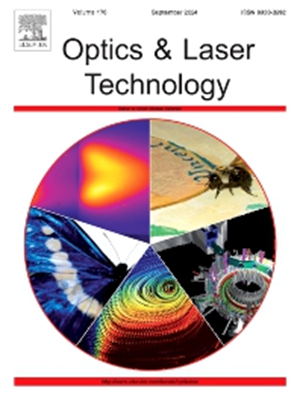In-situ surface inspection for wire-arc directed energy deposition integrating 3D topography reconstruction, defect detection and roughness measurement
IF 4.6
2区 物理与天体物理
Q1 OPTICS
引用次数: 0
Abstract
In wire-arc directed energy deposition (WA-DED), the in-situ surface inspection is imperative for acquiring 3D topographies, detecting weld bead surface defects, and measuring surface roughness to facilitate autonomous quality evaluation and repair path generation. However, existing offline inspection methods fail to provide comprehensive, real-time surface characterization. To address this limitation, a laser vision-based in-situ inspection system, where 3D topography reconstruction, defect detection and roughness measurement are innovatively integrated into a unified real-time scanning task, is developed. The inspection system consists of three subprocesses running simultaneously. By employing the novel laser centerline extraction algorithm CIICEA alongside the novel spatial curve fitting algorithm K-QCBFA, the complete 3D topographies of the printed geometries are reconstructed with a high precision of 0.247 mm. Surface hump and depression defects on the weld bead are identified and classified with a high accuracy of 97.44 % by applying the specific defect detection criterion derived from the analysis of the weld bead height difference curve. Utilizing the surface datum plane determined by the RANSAC algorithm, the geometrical indices for surface roughness, including , , and , are quantitatively evaluated with errors of ≤ 0.1558 mm. Experimental validations demonstrate that the system provides comprehensive multi-source surface information during the WA-DED process, capabilities not achievable with single-function inspection technologies, thus enabling sufficient data for effective part quality improvement.
求助全文
约1分钟内获得全文
求助全文
来源期刊
CiteScore
8.50
自引率
10.00%
发文量
1060
审稿时长
3.4 months
期刊介绍:
Optics & Laser Technology aims to provide a vehicle for the publication of a broad range of high quality research and review papers in those fields of scientific and engineering research appertaining to the development and application of the technology of optics and lasers. Papers describing original work in these areas are submitted to rigorous refereeing prior to acceptance for publication.
The scope of Optics & Laser Technology encompasses, but is not restricted to, the following areas:
•development in all types of lasers
•developments in optoelectronic devices and photonics
•developments in new photonics and optical concepts
•developments in conventional optics, optical instruments and components
•techniques of optical metrology, including interferometry and optical fibre sensors
•LIDAR and other non-contact optical measurement techniques, including optical methods in heat and fluid flow
•applications of lasers to materials processing, optical NDT display (including holography) and optical communication
•research and development in the field of laser safety including studies of hazards resulting from the applications of lasers (laser safety, hazards of laser fume)
•developments in optical computing and optical information processing
•developments in new optical materials
•developments in new optical characterization methods and techniques
•developments in quantum optics
•developments in light assisted micro and nanofabrication methods and techniques
•developments in nanophotonics and biophotonics
•developments in imaging processing and systems

 求助内容:
求助内容: 应助结果提醒方式:
应助结果提醒方式:


